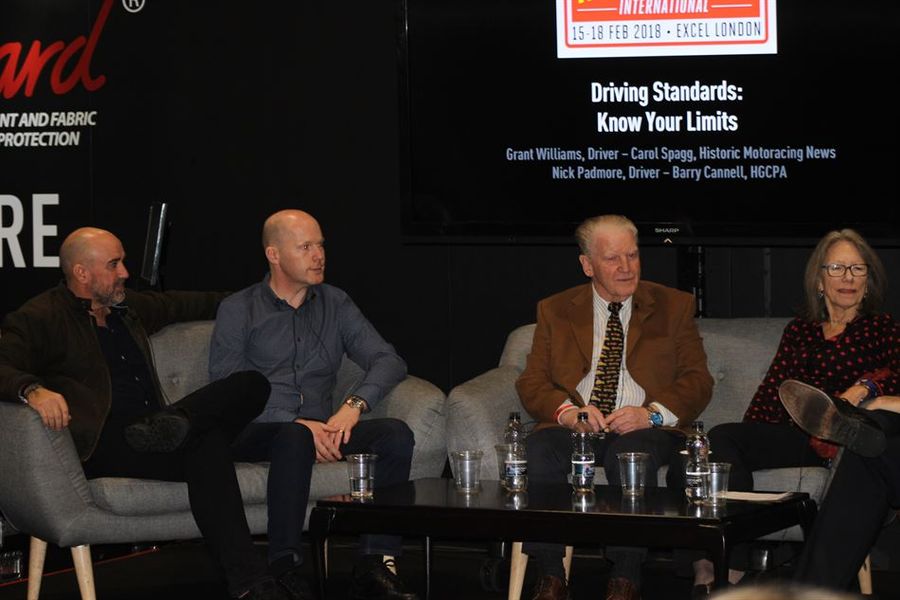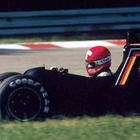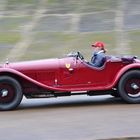HMI Panel Discussion: Driving Standards
- 7 Mar 2018
A feature of the recent Historic Motorsport International event at London’s Excel were the informative panel discussions hosted by Henry Hope-Frost. On the Friday morning Henry led a broad-ranging discussion on the subject of driving standards, and we can now bring you the full transcript.
The panel consisted of:
Barry Cannell – Historic Grand Prix Car Association
Nick Padmore – Race Driver
Carol Spagg – Historic Motorracing News and race series organiser
Grant Williams – Race Driver
Discussion:
Henry Hope-Frost: We are going to be talking about driving standards and trying to understand the new regime within racing to try to contain driving standards and the ramifications of that.
We have a diverse panel with Grant Williams, historic racer extraordinaire, Nick Padmore, Goodwood outright lap record holder and Formula One historic champion, Barry Cannell, driver and organiser within the Historic Grand Prix Cars Association, and Carol Spagg of Historic Motorracing News, who also organise the Under Two Litre Touring Car Championship.
HHF: Carol, firstly, do you think historic motorsport is one of the fastest growing area of our sport?
Carol Spagg: Absolutely, and according to the FIA it the fastest growing sector.
HHF: Why do you think that is?
CS: It is just so accessible on so many levels. From club racing to the big international competitions there is a level for everyone and it is a very friendly, welcoming discipline and people who are new are welcomed.
HHF: Is it because modern motorsport is boring? A lot of modern motorsport is very dry, very corporate, you can’t see drivers at work, get close to them.
CS: It’s true that in historic motorsport we have open paddocks and people can come and see the cars, see the drivers, even stand in the pitlane sometimes.
HHF: AS a championship organiser, you are very hot on driving standards aren’t you?
CS: WE try very hard to keep things under control. For some reason, touring car drivers seem to think that using another car to get them round the corner and hold them on the track is acceptable.
I really believe that with historic motorsport it should be different. There is a big distinction in my mind – not always in the drivers’ mind – that in in historic motorsport there should be no contact ever.
HHF: is that the impossible dream?
CS: Yes!
HHF: Barry, you are involved in single seaters, and that is a bit of a different kettle of fish – rubbing is not racing in single seaters?
Barry Cannell: Rubbing is patently dangerous as we are open wheeled cars and by definition you can have a catastrophic counter-rotating spin up in the air incident. Our cars are inherently more dangerous and we have a duty of care to our drivers, and must not drive beyond our limits.
If you are going to put one down the inside and take a place, you have to do it with total confidence that you are going to be there before the guy turns the wheel, that you are going to make it your corner – or you don’t make it at all. Those of us on the board of the HGPCA find we are having to provide an additional layer of control beyond that the Clerk of the Course might be able to administer.
Most front-running racing drivers occasionally have to go and face the Clerk of the Course, that is just the way it is, but we also have to call the tune. When we indict a new member, he may be a great driver but he has a white spot on the back of his car, he has to agree to have it. You are interacting with other drivers who don’t know you, and you may be a great driver, but you are in with a new set of guys.
We are pretty much the same set of 30 or 40 cars at most meetings, we know each other well, and we have had a good couple of years now with nothing much going wrong. We have a director who undertakes the management of driving standards, we have a record book, a formal procedure of cautioning members, and they find they are not members very long if they don’t acknowledge the responsibility they have.
HHF: So that is above and beyond what the MSA or the Stewards of the meeting might do or not do?
BC: I’m afraid it is, we have to be safe policing as the standard to which the Clerk of the Course will make a judgement means it always comes up as a racing incident. We don’t want racing incidents.
The Clerk’s decision is technical one, made from his years of experience, and he will say it is a racing incident, the fact that he spun off – racing incident. It might be a racing incident, but you are going to have to be spoken to by our director and warned that we don’t want another incident.
We don’t go over or beyond the Clerk of the Course, but we create another layer.
HHF: Nick Padmore, is that all a bit Big Brother? The sort of cars that you race, back in the day it was a bit each to their own, but now you are being watched with track limits etc.?
Nick Padmore: They are, I had an incident I was involved with at the Silverstone Classic in a sportscar race, took a big hit, and I went off.
I was amazed that with the different camera angles, so accident looked so different.
Going back to Barry and the HGPCA, that series is brilliant. I have seen video where other drivers wave you past if you are quicker, and it is very well-behaved, and if there is a bit of room then it is ‘after you old chap’.
BC: If I can come in briefly, the demographics of our members, we are the guys living the dream, we are the guys driving the cars that were the Grand Prix cars that our heroes drove when we were young men.
NP: Some of your guys are very brave, I have driven that Lotus 16 and when it broke down I felt ‘thank God for that, I’m out!”
HHF: are you a man or a mouse? [Laughing]
Grant Williams: I’ll drive it! I’ll jump in the car!
BC: My point about the demographic is that we are mature people – quite old a lot of us – and we don’t want to hurt ourselves, we are living the dream. No-one is around the corner looking to recruit us to drive for their team and we are out in our own cars trying to keep safe and have that thrill of driving the wonderful single-seater Grand Prix cars of the 50s and 60s.
We are doing it and the paramount thing is that we stay safe. We probably administer on a safer level to say that safety is paramount, winning is second.
NP: The social side of your series is great too.
HHF: The legendary HGPCA barbecues!
NP: You make the weekend fun, everyone is there together.
HHF: YOU are reflecting the attitude of the day. If you talk to someone like Sir Stirling Moss about it, you simply didn’t drive into your mate, as they would be a sheer drop or a tree there. It was almost an unwritten rule, a gentleman’s agreement. But it hasn’t slowed you down has it?
GW: I try very hard to respect the track limits, and most of the time the car is sliding anyway, and if it does go over the white line I do worry about it sometimes. The Revival is a different thing altogether, most of the chicane I am on the grass. At Woodcote I used to drive across the chicane, but I am always wary of it.
I did a race at Donington last year and went through the first couple of corners obeying the track limits and the white lines, looked at everyone else and they were over the lines and on the grass. I was a second and a half off the pace, so started following the group, using the pace, and ended up on pole.
That is the difference, they are not controlled at the moment but they will be eventually.
HHF: So sideways isn’t always best then?
GW: For me it is, but not for everyone. I am quicker going sideways than in a straight-line, and it has always been the same.
NP: If you go testing at Brands Hatch or Snetterton, if you go over a kerb and possible touch Mr Palmer’s grass, you get a photo and a warning – on a test day. So, if you are going to do it, do it properly so it looks good for the camera!
CS: I would make the point that historic motorsport has a lot of ex-professionals involved but is basically an amateur sport, for people who are not professional drivers. There is a lot of mixed ability in there, people who are not so quick, people who are very quick and who are in total control of their car at all times, people who like to have the back end hanging out all the time, and others who are much more cautious.
A lot of incidents occur, not because anyone deliberately cuts someone off or was too aggressive, but they just lost control of their cars and went into someone else. Then it is always “I’m sorry about that, my brakes didn’t work’, your brakes didn’t work mate because you left your braking too late!
You have to learn how to drive your own car and you have to be in control of it your car, because otherwise you are going to hit somebody else at some point.
HHF: There is a bit of the ego- money thing being an issue in historic racing? There are lots of wealthy people who aren’t as good as they think they are, and I can say that hand on heart as a man who is rubbish and poor!
BC: I can only look at my own group of racers in answer to that question, and I don’t think we have that problem. When you get out there in a single-seater you feel fragile, and if you drive beyond your ability you are going to hurt yourself. You have your own discipline which will be more important than your ego.
Nick has joined us of late with a client who is enjoying it very much, and he has driven a lot of other cars but when he comes to the HGPCA he has a different head on. These are 50s and 60s single seaters, I remember when I first had a six-point harness, I had driven cars with no seat belts at all and suddenly I was a lot braver. When I got into a tin top with a rollbar I was yet braver again.
You drive to your concept of your own ability and keeping yourself safe.
HHF: Nick, you are hammering round Spa in a Williams FW07, pre-carbon-fibre, your feet are on the front axle line or possibly a bit in front of it, is preservation always in your mind?
NP: I don’t think I have ever looked where my feet or legs are, but it isn’t my car so you drive it to a level. You use your head, you do not want to go off as it is going to hurt at those speeds.
When I get in the Lotus 16 though I really do think about that, you are so exposed, the wheels are right there, you are covered in oil – but what an experience to drive something like that.
HHF: You guys are front-runners in your various categories, are driving standards a problem?
GW: Slower cars are the issue more than anything. You are not exactly much faster in a straight line, but you can carry more corner speed.
They are not being driven badly, just slower, and standards are pretty good, I have to be fair. People will move and tend to use their mirrors more these days. You get the odd occasion where you end up giving a gesture out the window as you go past and next time they know you are there.
BC: If I can just come in, we have a concept of ‘has he seen me or not’. If you were in my car, which is one of the quicker cars on the grid, which means I lap some of the slower cars, and you are arriving at a corner, if I am not sure someone is giving me the corner I back off.
If I was in a tip-top, and leading the race, I would probably take the chance.
GW: I lost a win at the Revival to Andrew Jordan because I thought I had a lap left, so would wait another lap before trying to go past – but I had come from the back of the grid mind!
HHF: Are standards improving compared with five or ten years ago?
GW: Definitely, people are more aware of what can go wrong.
HHF: Is that because of driver’s attitudes, the policing, or a bit of both?
NP: It is definitely a bit of both. In something like the Can-Am race at Goodwood, it is the observation of a driver that is important, the cars are very fast and you have some big speed differences.
I remember one year catching a group of five cars going into Lavant, and you arrive there going so fast, and they were just not looking what is going on. The worry is it is a very fast race, and people can go and buy a Can-Am car and decide they are going to do that race first time out in the car – and I think that has to be looked at a bit. It is a very fast track, no run-off, and they are very fast cars.
HHF: You have to have a certain CV don’t you, Goodwood won’t let anybody drive in the Whitsun Trophy would they?
NP: They should certainly have raced or tested the car before, yes.
GW: Some people though are just turning up and jumping in the car. Not even testing. Jochen Mass drove my car, he just turned up and jumped in it, no testing whatsoever.
HHF: His is a bit different though!
NP: He’s done a bit in the past!
CS: One of the subjects that always comes up when the FIA Historic Committee meets is licencing. Those of us involved in international racing, we have people of lots of different nationalities on the grid, and in some contrived you go out and get a licence, and you can go and jump into a Can-Am car and that would be your first race.
I have been in international races where people are doing their first race in a highly competitive and fast car, at a circuit like Spa. The country that they come from they don’t need experience to get a licence, whereas in this country you have to do a set number of races to get a licence.
HHF: Shouldn’t you have each ASN (national body) working to the same standard, so you need six signatures on your licence to move up in grade?
CS: No, they can’t that is why they keep talking about it.
BC: We have come across drivers at Monaco of all places making their first drive in a motor racing event. We had a grid, not an HGPCA grid but 90% of the drivers were our members, and the guy was a continental, didn’t understand the driver’s briefings, certainly didn’t understand his car, and it was a disaster.
The other drivers just had to work with the fact that a guy was out on the circuit who couldn’t drive, he literally could not mechanically drive his car properly, let alone race it properly.
I think it the same in all of our racing, we have members of very mixed ability. We have young men like William Nuttall, 29 years of age, drives all sorts of cars, lovely young fellow, goes like the wind, and then we have guys in their 70s who are possibly a dozen seconds slower a lap than Will. I have to say, the older guys can only do a couple of things they can steer and brake, but they can’t look in their mirrors, they can’t do three things at a time! They have very limited ability, but our control is to say that ‘we know you are not the nuts, you know you are not the nuts, just make sure you do everything safely, we value you like anyone else’.
It is when people drive beyond their ability our problems start. We are talking about driving ability and driving standards, and I take driving standards to be the administration by the race organisers of keeping people safe. We have words with people.
HHF: I’d be terrified!
BC: And so you should be!
HHF: Let’s talk about 2018 and all your plans. You going to be out in BUY 1 again?
GW: Hopefully! I have a couple of rounds to do this year, mainly in the GRRC. I think I have a drive this year in an LMP2 car at Spa, hopefully what will be quite nice.
HHF: So that has downforce and you mustn’t be sideways?
GW: I have had a couple of test sessions and I was two seconds quicker than his paid driver so… It was totally alien as I had never been in anything like that before but if soon felt very comfortable and I felt at home and got quicker and quicker.
NP: Hopefully a busy year, we have the Members’ Meeting in a BMW, and hopefully something else. Then the Masters Formula One and the Monaco historic which is brilliant. Then we have Classic Le Mans and it has just been announced there will be a historic Formula One race at the British Grand Prix. It should be busy.
HHF: You going to defend your FIA Master F1 title?
NP: I’d like to get the Williams back out if we are allowed and see what we can do.
HHF: have they pegged the ground-effects cars back a bit?
NP: Yes, the rule shave changed quite a bit to slow the cars down, and the ground-effect cars will be quite ab it slower. It brings the pre-ground effect and flat bottom cars closer.
I can see why they are doing it, reverse grids as well, and it’s going to make it more interesting, but the Williams won’t be as grippy as it should be.
HHF: Barry, another big year for HGPCA on the cards?
BC: Any extra year racing for me at my age is a big year! I intend to have a very full season, I’ll be at the Member’s Meeting in my little Cooper Bobtail.
HHF: you go very well in that, I’ve interviewed you on the podium!
BC: No, that was my Cooper T51 Grand Prix car when I won last year. My season then is my Brabham in every HGPCA race meeting, six meetings on the Continent, two in the UK. I am sharing a Cooper Monaco in the Sir Stirling Moss Trophy, so I am having as much fun as I am allowed to have.
Carol: The U2TC, as big and as popular as ever?
CS: The U2TC is going strong and is as competitive as ever, entries are coming in nicely and we will see how it shapes up. We are also doing this year the Tourist Trophy race at Silverstone for Pre-63 GT cars, which is going very nicely for us and DK Engineering has stepped in to sponsor a three-race series. We will have Pre-63 at Donington, Silverstone and the Algarve at the end of the season, and we have had an overwhelming amount of interest in that.
To me, those early GT cars are the loveliest cars out there and that is a series for actual historic cars, MGA team and that sort of thing which are the actual real cars. We have no problem with driving standards as people are just so happy to go out and drive those cars.
HHF: Thank you everybody, enjoy the rest of the show!











